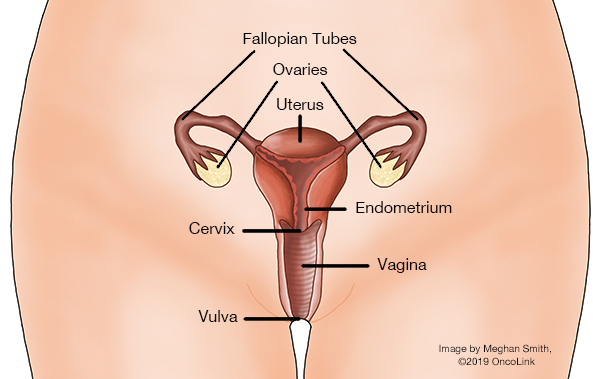Surgical Procedures: Surgical Staging for Cervical Cancer
What is cervical cancer?
Cancerous cells in the tissue of the uterine cervix are called cervical cancer. Cervical cancer is often caused by the human papillomavirus (HPV).
What is staging and how is it done?
Once a diagnosis of cervical cancer has been made, you will need testing to determine the stage (extent) of your cancer. These tests can include:
- CT scan.
- Positron emission tomography scan (PET scan).
- Magnetic resonance imaging (MRI).
- Ultrasound.
- Chest X-Ray.
- IVP (intravenous pyelogram, which looks at urinary structures).
In some cases, you may have a cystoscopy (to look inside your bladder) or a proctoscopy (to look inside the rectum). Surgery may be used to stage the cancer before any other treatment.
Cervical cancer spreads to other parts of the body through the lymph and blood systems. Cancer stage determines how extensive the cancer is, if and how far it has spread, and what treatment course will be recommended.
Two staging systems are used to determine the stage of your cancer:
- The FIGO staging system (International Federation of Gynecology and Obstetrics).
- The American Joint Committee on Cancer TNM staging system.
Both of these staging systems will give your healthcare team information on the extent of the tumor (T), spread to the lymph nodes (N) and distant metastasis (spread) (M).
What surgical procedures are used in the diagnosis and treatment of cervical cancer?
It is often recommended that women with stage 0 (carcinoma in-situ) to stage IVA cervical cancer have surgery. There are many surgeries that can be used, depending on your stage and situation. They include:
- Cervical Conization: Removal of a cone shaped wedge from the cervix and cervical canal. It can be used to diagnose and/or to treat the cancer. This may be done using:
- Cold-Knife Cone (CKC): A scalpel is used during this conization procedure.
- Loop Electrosurgical Excision Procedure (LEEP): A wire with an electrical current is used during this conization procedure.
- Laser: A laser beam is used to remove precancerous lesions on the surface of the cervix.
- Cryosurgery: Liquid nitrogen is applied to pre-cancerous cells in the vagina and cervix.
- Total Hysterectomy: Removal the uterus and the cervix. In some cases, the ovaries and fallopian tubes will not be removed and will be kept in place.
- Radical Hysterectomy: Removal of the uterus, cervix, tissue surrounding the cervix, and the upper part of the vagina. The fallopian tubes and lymph nodes may or may not be removed.
- Modified Radical Hysterectomy: Removal of the uterus, cervix, tissue/ligaments surrounding the cervix, and the upper part of the vagina. Some lymph nodes may or may not be removed.
- Radical Trachelectomy: Removal of the cervix, nearby tissue, lymph nodes and upper vagina, leaving behind the uterus and ovaries.
- Bilateral Salpingo-Oophorectomy (BSO): Removal of ovaries and fallopian tubes on both sides.
- Pelvic Exenteration: Removal of a woman’s uterus, cervix, ovaries, fallopian tubes, vagina and at times, the bladder, urethra and/or bowel, anus and rectum.
- Pelvic Lymph Node Dissection: Removal of lymph nodes to test for metastatic cancer (cancer that has spread).
A hysterectomy can be done using a few different surgical approaches, such as:
- Abdominal (Belly): An incision is made into the abdomen (belly) to remove the uterus.
- Vaginal: An incision is made in the upper vagina, and the uterus is removed through this cut.
- Laparoscopic: A laparoscope (lighted tube with a camera) is used. This procedure uses small incisions in the abdomen where the tools are inserted.
- Robotic: The surgeon controls a robotic arm to perform the surgery through small incisions.
What is recovery like?
Recovery from surgery for cervical cancer will include a stay in the hospital for one to several days, depending on the type of procedure you have had.
When you are home, be sure to take your prescribed medications as directed to prevent pain, infection and/or constipation. Call your team with any new or worsening symptoms.
Your healthcare provider will talk with you about any changes you will need to make in your activity level.
How can I care for myself?
You may need a family member or friend to help you with your daily tasks until you are feeling better. It may take some time before your team tells you that it is ok to go back to your normal activity.
Be sure to take your prescribed medications as directed to prevent pain, infection and/or constipation. Call your team with any new or worsening symptoms.
There are ways to manage constipation after your surgery. You can change your diet, drink more fluids, and take over-the-counter medications. Talk with your care team before taking any medications for constipation.
Taking deep breaths and resting can help manage pain, keep your lungs healthy after anesthesia, and promote good drainage of lymphatic fluid. Try to do deep breathing and relaxation exercises a few times a day in the first week, or when you notice you are extra tense.
- Example of a relaxation exercise: While sitting, close your eyes and take 5-10 slow deep breaths. Relax your muscles. Slowly roll your head and shoulders.
This article contains general information. Please be sure to talk to your care team about your specific plan and recovery.
References
American Cancer Society. (2020). Cervical cancer stages: How to stage cervical cancer. Retrieved from https://www.cancer.org/cancer/cervical-cancer/detection-diagnosis-staging/staged.html
American Society of Clinical Oncology (ASCO). (2022). Cervical cancer: stages. Retrieved from https://www.cancer.net/cancer-types/cervical-cancer/stages
